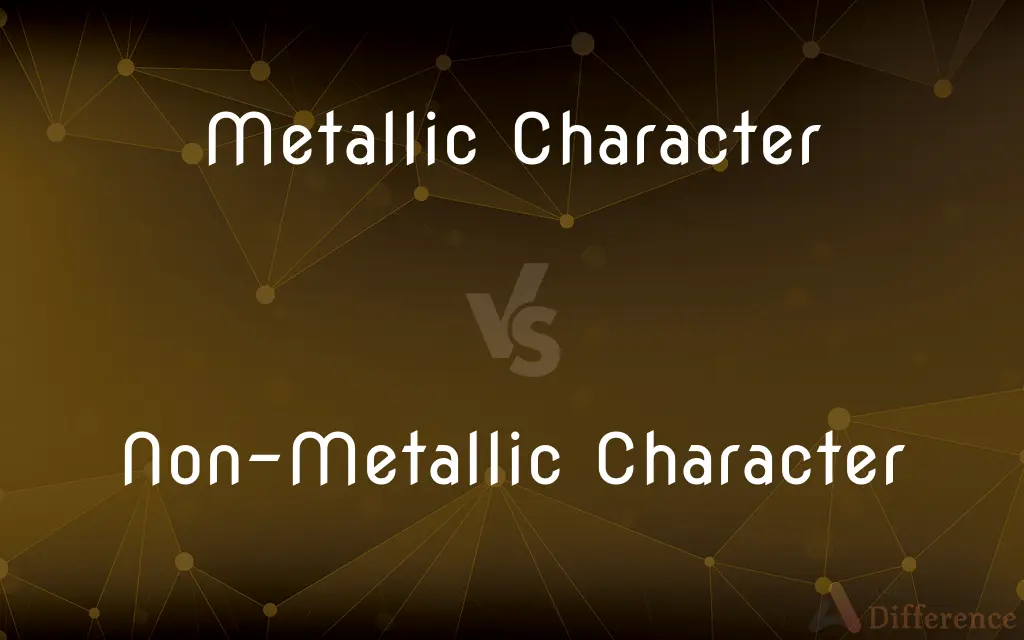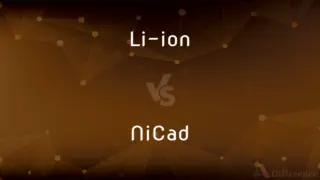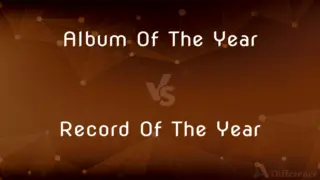Metallic Character vs. Non-Metallic Character — What's the Difference?
By Tayyaba Rehman & Urooj Arif — Published on February 10, 2024
Metallic character refers to elements' tendency to lose electrons and form positive ions, while non-metallic character involves gaining electrons to form negative ions.

Difference Between Metallic Character and Non-Metallic Character
Table of Contents
ADVERTISEMENT
Key Differences
Metallic character is a term used in chemistry to describe the set of properties associated with metals, including malleability, ductility, and the ability to conduct electricity and heat. Metals tend to lose electrons easily, forming positive ions. This character is prominent in elements located on the left side and towards the bottom of the periodic table. The metallic character decreases across a period from left to right as elements become less willing to lose electrons and more inclined to gain them.
Non-metallic character, on the other hand, refers to the tendency of an element to gain electrons and form negative ions, a trait common among non-metals. This character is associated with properties such as brittleness, lack of luster, and poor conductivity of heat and electricity. Non-metallic character increases across a period from left to right, as the elements become more electronegative and more likely to accept electrons. It is most pronounced in elements located on the right side and towards the top of the periodic table.
The distinction between metallic and non-metallic character lies in their electron configuration and reactivity. While metallic elements are characterized by their ability to lose electrons and form cations, non-metallic elements are defined by their propensity to gain electrons and form anions. This fundamental difference influences their chemical behavior and the types of compounds they form.
In terms of chemical reactivity, metallic character is associated with a low electronegativity and a low ionization energy, meaning metals can easily donate electrons in chemical reactions. Non-metallic character, conversely, is linked to high electronegativity and high ionization energy, indicating a preference for accepting electrons during chemical interactions.
The transition from metallic to non-metallic character across the periodic table highlights the diversity of element properties. Elements exhibit a gradual change from the highly reactive metals of the alkali and alkaline earth groups to the highly reactive non-metals of the halogens, reflecting the complex interplay of electron configurations and elemental properties.
ADVERTISEMENT
Comparison Chart
Electron Affinity
Low, tends to lose electrons.
High, tends to gain electrons.
Ion Formation
Forms cations (+ ions).
Forms anions (- ions).
Conductivity
High thermal and electrical conductivity.
Poor thermal and electrical conductivity.
Physical State
Mostly solid at room temperature (except Hg).
Can be gases, liquids, or solids.
Chemical Reactivity
Generally less electronegative, reactive.
More electronegative, highly reactive.
Compare with Definitions
Metallic Character
Reflects the ease with which an element engages in oxidation.
Aluminum shows its metallic character by easily oxidizing to form Al3+ in reactions.
Non-Metallic Character
A measure of how readily an element accepts electrons in chemical reactions.
Oxygen shows non-metallic character by accepting two electrons to form O2-.
Metallic Character
A measure of how readily an element can donate electrons in chemical reactions.
Magnesium displays its metallic character by donating two electrons to form Mg2+.
Non-Metallic Character
The propensity of an element to form covalent bonds rather than metallic bonds.
Carbon exhibits non-metallic character by forming covalent bonds in diamond and graphite.
Metallic Character
The tendency of an element to form metallic bonds and metallic structures.
Iron's metallic character facilitates the formation of a crystal lattice in its solid state.
Non-Metallic Character
The tendency of an element to gain electrons and form negative ions.
Chlorine demonstrates its non-metallic character by gaining an electron to become Cl-.
Metallic Character
The propensity of an element to lose electrons and form positive ions.
Sodium exhibits a high metallic character when it readily loses an electron to form Na+.
Non-Metallic Character
Reflects the ease with which an element engages in reduction.
Fluorine displays its non-metallic character by being highly electronegative and readily reduced.
Metallic Character
The extent to which an element exhibits properties such as malleability and conductivity.
Copper's metallic character is evident in its excellent electrical conductivity.
Non-Metallic Character
The degree to which an element exhibits properties like poor conductivity and brittleness.
Sulfur's non-metallic character is evident in its poor electrical conductivity.
Common Curiosities
Can an element have both metallic and non-metallic character?
Elements tend to exhibit either metallic or non-metallic character, but metalloids have properties of both.
How does metallic character change across the periodic table?
Metallic character decreases from left to right across a period and increases down a group.
What defines metallic character?
Metallic character is defined by an element's ability to lose electrons and exhibit properties like conductivity and malleability.
What causes the difference in metallic and non-metallic character?
The difference is caused by variations in elements' electron configurations and their ability to lose or gain electrons.
How is non-metallic character identified?
Non-metallic character is identified by an element's propensity to gain electrons and display properties such as poor conductivity and brittleness.
Can the metallic character of an element change under different conditions?
While the intrinsic metallic character of an element remains constant, its reactivity can change under different physical or chemical conditions.
Are metals or non-metals more abundant in the Earth's crust?
Non-metals are more abundant in the Earth's crust, particularly oxygen and silicon.
What role does electronegativity play in non-metallic character?
High electronegativity is a key factor in non-metallic character, indicating a strong tendency to attract and gain electrons.
How does metallic character affect an element's chemical reactivity?
Elements with high metallic character tend to be more reactive, especially with non-metals, due to their tendency to lose electrons.
How is non-metallic character related to acidity and basicity?
Non-metallic character is often associated with acidity, as non-metals tend to form acidic oxides, while metals form basic oxides.
Why do metals tend to form cations while non-metals form anions?
Metals lose electrons easily due to their low ionization energy, forming cations, while non-metals gain electrons due to high electron affinity, forming anions.
Can metallic and non-metallic characters predict compound formation?
Yes, the character can predict how elements will combine, with metals often forming ionic compounds with non-metals.
What is a metalloid, and how does it relate to metallic and non-metallic characters?
Metalloids have properties intermediate between metals and non-metals, exhibiting both metallic and non-metallic characters in different conditions.
How does the metallic character influence an element's state at room temperature?
Elements with high metallic character are typically solid at room temperature, except for mercury, which is a liquid.
What is the significance of metallic and non-metallic character in industrial applications?
Understanding these characters helps in selecting materials for specific applications, like metals for conductive paths and non-metals for insulators.
Share Your Discovery

Previous Comparison
Li-ion vs. NiCad
Next Comparison
Album Of The Year vs. Record Of The YearAuthor Spotlight
Written by
Tayyaba RehmanTayyaba Rehman is a distinguished writer, currently serving as a primary contributor to askdifference.com. As a researcher in semantics and etymology, Tayyaba's passion for the complexity of languages and their distinctions has found a perfect home on the platform. Tayyaba delves into the intricacies of language, distinguishing between commonly confused words and phrases, thereby providing clarity for readers worldwide.
Co-written by
Urooj ArifUrooj is a skilled content writer at Ask Difference, known for her exceptional ability to simplify complex topics into engaging and informative content. With a passion for research and a flair for clear, concise writing, she consistently delivers articles that resonate with our diverse audience.
















































